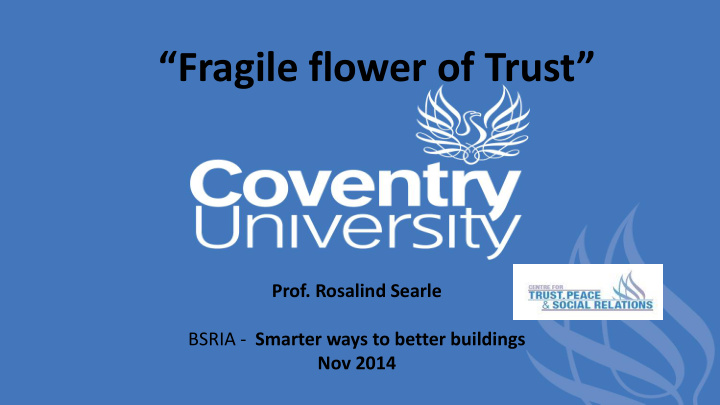



“Fragile flower of Trust” Prof. Rosalind Searle BSRIA - Smarter ways to better buildings Nov 2014
What is trust? Risk Confidence Vulnerability Trust is a ‘willingness to be vulnerable to the actions of a trustee based on the positive expectations that the other will perform a particular action, irrespective of any monitoring or control mechanism’ (Mayer et al, 1995; Rousseau et al, 1998)
Trust = trustworthiness (Dietz and Den Hartog 2005, Searle et al, 2011) Ability Benevolence Integrity Predictability
Why does trust matter? Searle 2013 With Veronica Hope Hailey and Graham Dietz
Edelman Trust barometer 2011
Understanding trust in org Searle 2014 Externals trust in Looking the organisation In Centre for Trust, Peace & Social Relations
Understanding trust in org Searle 2014 Externals trust in Looking the organisation In internals trust in the wider context Looking - The public, out - customers, - competitors Centre for Trust, Peace & Social Relations
Understanding trust in org Searle 2014 Externals trust in Looking In the organisation internals trust in Looking out the wider context - The public, Internals trust in Looking about - customers, the organisation - competitors Centre for Trust, Peace & Social Relations
Elements of the process
What matters most for leaders? Legood ‘13 Centre for Trust, Peace & Social Relations integrity ability
Coventry Business School Thank you and any questions Rosalind.searle@coventry.ac.uk.... Twitter @profsearle Hatzakis, T. and R.H. Searle (2006). Grounding trust in inter-organizational alliances: An exploration of trust evolution. International review of management studies 17 (1), 72 - 89
Recommend
More recommend